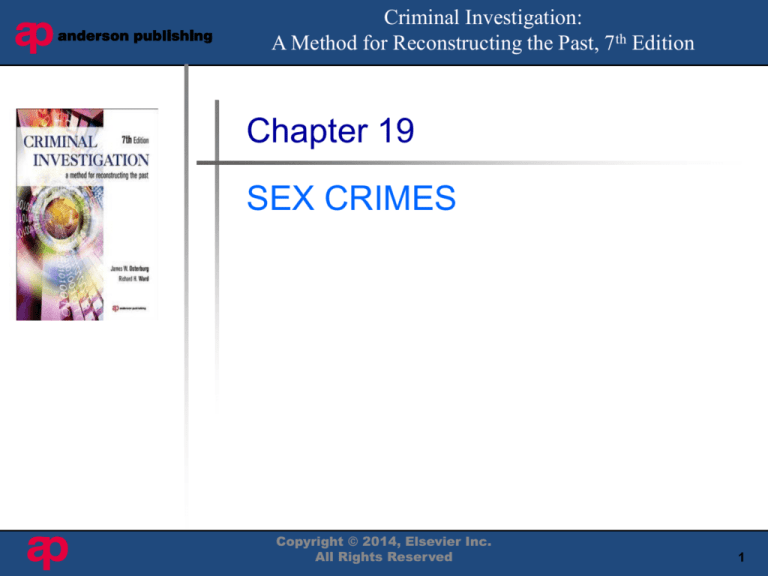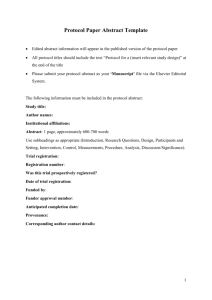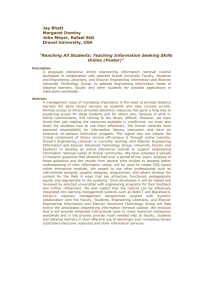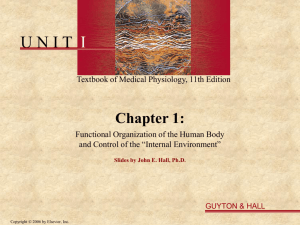
Criminal Investigation:
A Method for Reconstructing the Past, 7th Edition
Book
Cover
Here
Chapter 19
SEX CRIMES
Copyright © 2014, Elsevier Inc.
All Rights Reserved
1
Sex Crimes
• UCR revised the definition of Rape in 2013
• Many definitions/elements
– Sex crimes range from indecent exposure to
forcible rape
– Mutual consent issues
– Children cannot consent
• Corpus Delicti
• Stalking/Cyberstalking
• Child Exploitation
Copyright © 2014, Elsevier Inc.
All Rights Reserved
2
Definitions
• Issue of mutual consent
– Key defense contention
• Some acts involve full consent between parties, but are
illegal in particular jurisdictions
– “acquaintance rape” / “date rape”
• Forcible rape or sodomy, coupled with murder
– Most serious sex connected crime from the perception of
the public
• All rapes and serious sexual assaults must have a high
priority in the investigative universe
– Frequently difficult to prove in a court of law, and
offenders have gone free because of a lazy or sloppy
investigation
Copyright © 2014, Elsevier Inc.
All Rights Reserved
3
Corpus Delicti
• Legal definition of rape generally involves:
– Sexual penetration, however slight, of the victim’s
vulva
– By a person or persons without the victim’s
consent
– Or with a minor child
Copyright © 2014, Elsevier Inc.
All Rights Reserved
4
Sex Crimes
• Sex crimes include other forms of aberrant
behavior:
– Sexual assault
– Child abuse and molestation, also known as
pedophilia
– Some forms of pornography
– Indecent exposure
– Incest
– Stalking
Copyright © 2014, Elsevier Inc.
All Rights Reserved
5
Stalking
• Involves conduct that is directed at a specific
person or persons, that seriously alarms,
annoys, intimidates, or harasses the person(s),
and that serves no legitimate purpose
• May involve telephone calls, notes or letters,
confrontations, and following a person or
persons
• Need to understand the reasons for stalking
Copyright © 2014, Elsevier Inc.
All Rights Reserved
6
Types of Stalkers
•
•
•
•
•
•
•
•
Psychopathic Personality
Psychotic Personality
Celebrity
Lust
“Hit Man”
Love-Scorned
Domestic
Political
Copyright © 2014, Elsevier Inc.
All Rights Reserved
7
People
• Victims and Witnesses
• Interviews
– Preliminary
– Follow-up
• Interviewing Children
Copyright © 2014, Elsevier Inc.
All Rights Reserved
8
Conducting the Investigation
• Physical Evidence
• Goal of the crime scene search is:
– Link the victim and offender to the crime scene
– Establish that sexual relations took place
– Establish that coercion, fear, or force was used
– Establish the offender’s role or activity
• Records and Other Sources of Information
Copyright © 2014, Elsevier Inc.
All Rights Reserved
9
Goal of Preliminary Interview
•
•
•
•
A physical description of the offender or offenders
The location or locations where the crime took place
The identification of possible witnesses
Specific actions of the offender that are volunteered
by the victim
• Circumstances leading up to the attack
• Information on any weapon or vehicle that may have
been used
• Specific info on the actual location of the assault
Copyright © 2014, Elsevier Inc.
All Rights Reserved
10
Categories of Witnesses
• Those who can testify that the offender was
the victim
• Those who may be able to testify to specific
acts
• Hostile witnesses may claim that the victim
gave consent; others may be ashamed of
what they saw and might not want to
cooperate
– May lie to help a friend
Copyright © 2014, Elsevier Inc.
All Rights Reserved
11
Interviewing Children
• Assistance of trained professionals is
necessary
• Offender is frequently known to the child
• Child should be allowed to explain in his or
her own words
Copyright © 2014, Elsevier Inc.
All Rights Reserved
12
Records and Other Sources
• Sex offender record
• Sex offense may have been “crime of
opportunity”
• Recognize similar cases
• There may be a specific motive known only to
the perpetrator
– Rape is rarely associated with sexual gratification,
more likely associated with need for power
• Nature of attack
– Location, time of day, actions, etc.
Copyright © 2014, Elsevier Inc.
All Rights Reserved
13
Profiling Offenders
• Based on the theory that an individual
displays unique characteristics in
– Personality
– Crime scene behavior
– Method of operation
• Many are married and employed; not
oversexed; not women-haters; IQ varies
• Psychological issues, but not psychotic
Copyright © 2014, Elsevier Inc.
All Rights Reserved
14
Patterns
• Gang rape
– More than one assailant
• Elderly rape
– Offenders were young, white, single males
• Child rape
– Class-related
Copyright © 2014, Elsevier Inc.
All Rights Reserved
15
Profiling
• Profiling aids a reasoned, systematic process
for the investigation of rape and reduces the
possibility of investigative error
– Possibility that the offender will strike again or
that he has committed other crimes
– Unique characteristics
– Length of time
Copyright © 2014, Elsevier Inc.
All Rights Reserved
16
Hazelwood and Warren Study
• Study of 41 serial rapists
– 76% had been sexually abused as children
– 71% had been married at least once
– 54% had generally stable employment
– 52% scored above average on intelligence tests
– 51% had been in the armed forces
– 36% collected pornography
Copyright © 2014, Elsevier Inc.
All Rights Reserved
17
Follow-Up Activities
• Objective, reasoned approach
– Sympathetic understanding of victim trauma
– Unemotional attitude toward suspect
•
•
•
•
•
•
Explore all contentions (e.g., victim blaming)
Obtain detailed information
Cross-reference files
Review of evidence
Maintain quality records
Preserve evidence carefully
Copyright © 2014, Elsevier Inc.
All Rights Reserved
18
Conclusion
• Sex crime difficult to investigate
• Each case unique
• Communication abilities of investigators more
important than gender
• Knowledge of elements of the crime, and
techniques in interviewing and interrogation,
critical
Copyright © 2014, Elsevier Inc.
All Rights Reserved
19





